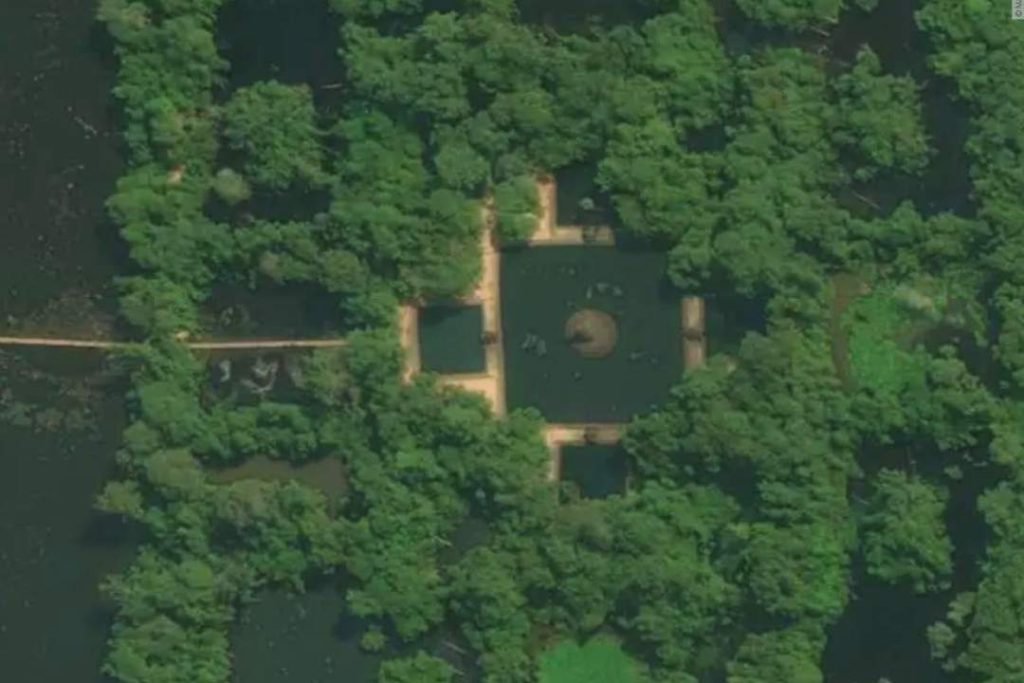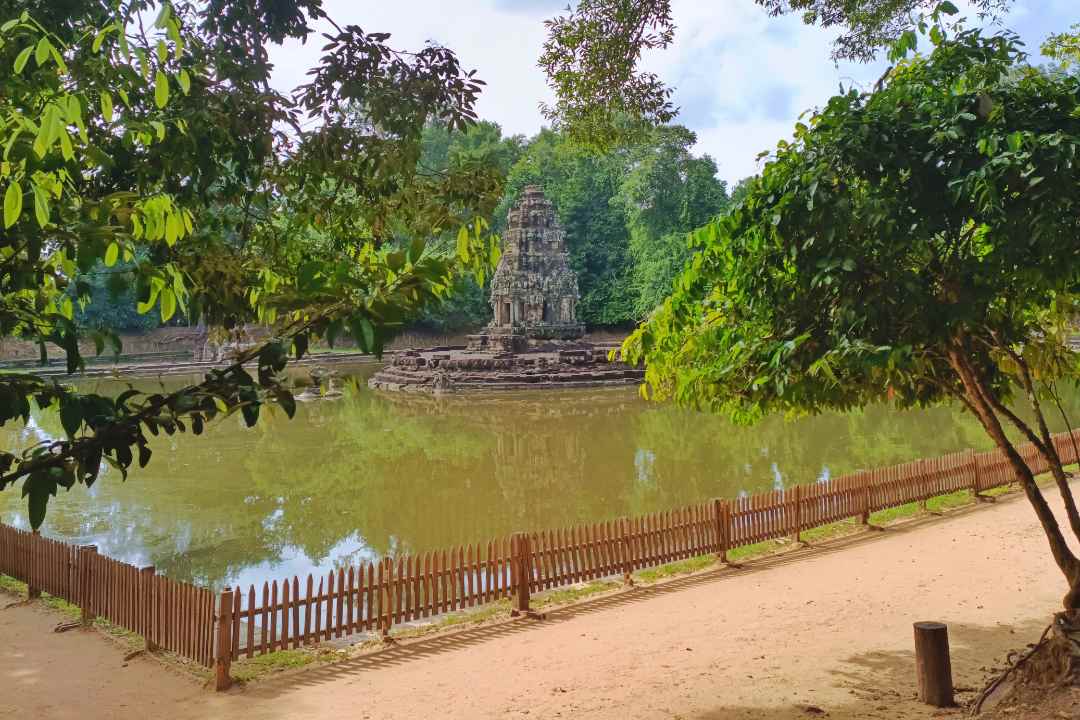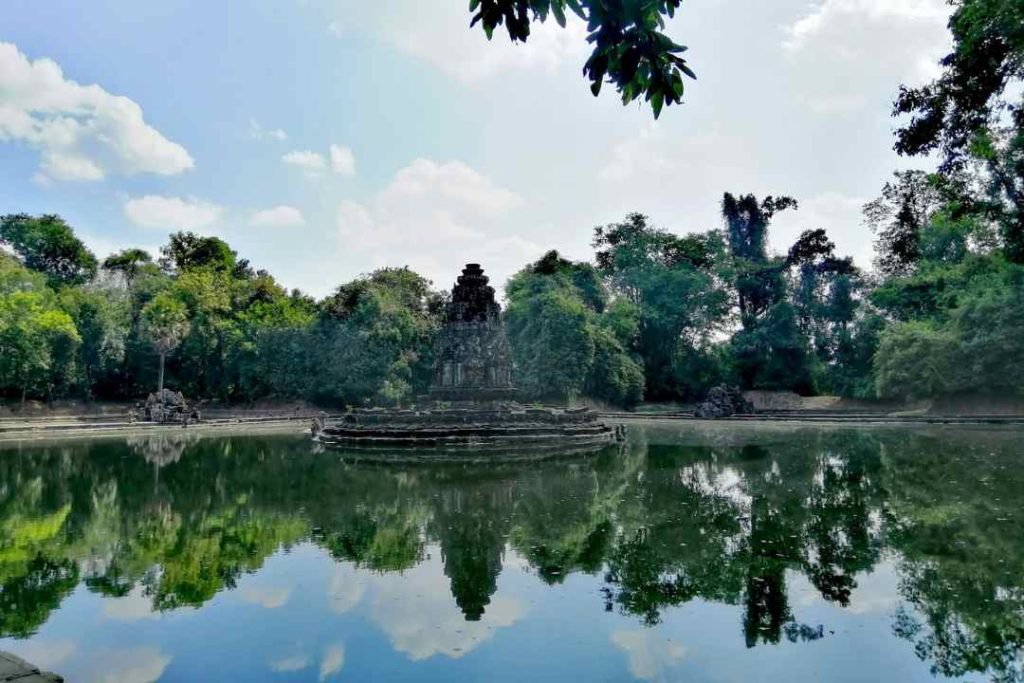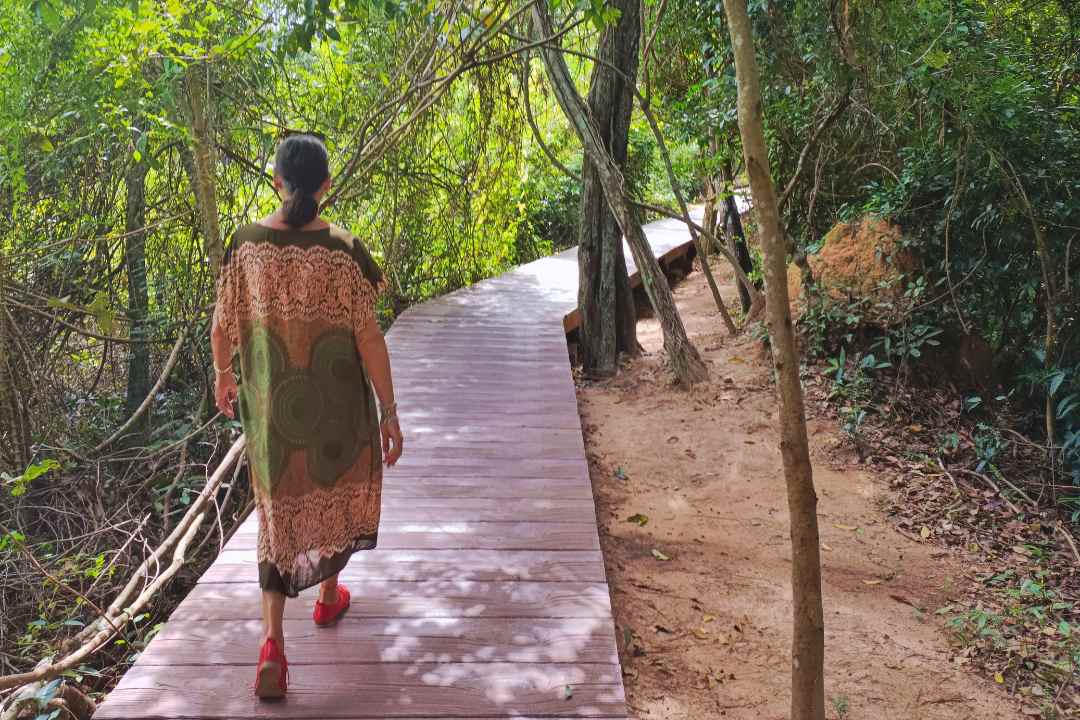Unraveling the Mysteries of an Ancient Healing Center
Discover the Enigmatic Neak Pean Temple
Welcome to the heart of Cambodia, where the ancient whispers of the Angkor Archaeological Park echo through time. Among the many wonders nestled within this historical treasure trove, one stands out for its unique charm and profound significance – the Neak Pean Temple.
This page enters a world where architecture, spirituality, and nature intertwine to create a unique spectacle. Welcome to Neak Pean, the ancient healing center of the Khmer Empire.
Join us as we unravel the mysteries of this architectural marvel and discover why it’s a must-visit on your Cambodian adventure.
This isn’t just another temple; it’s a testament to the architectural prowess and spiritual beliefs of the Khmer Empire.
Intrigued?
Let’s dive into the captivating world of Neak Pean and uncover its secrets.
A Journey Back in Time: The History of Neak Pean
Imagine stepping back into the 12th century, a time when King Jayavarman VII reigned over the Khmer Empire. A visionary and a devout Buddhist, the king embarked on a monumental project – the construction of Neak Pean.
| Historical Event | Description |
|---|---|
| Construction | King Jayavarman VII, known for his extensive building program, commissioned the construction of Neak Pean. |
| Name Significance | The name ‘Neak Pean’ translates to ‘entwined serpents’, a nod to the coiled naga sculptures that adorn the temple. |
| Mythical Connection | The temple’s design is believed to be inspired by the mythical lake Anavatapta, known in Buddhist and Hindu scriptures for its healing properties. |
Isn’t it fascinating how the past intertwines with mythology to create a narrative that’s both historical and mystical? Now, let’s explore what makes Neak Pean a must-visit spot in your Siem Reap adventure.
The Allure of Neak Pean: More Than Just a Temple
Neak Pean isn’t your typical temple. It’s an architectural marvel, a historical gem, and a spiritual sanctuary all rolled into one. But what makes it truly unique?
Picture this: A central pond surrounded by four smaller ones, each connected by stone conduits adorned with animal carvings. The central pond symbolizes the mythical lake Anavatapta, while the surrounding ones represent the four elements – Water, Earth, Fire, and Wind.
This intricate design isn’t just for show. It’s a reflection of the ancient belief in the healing power of balance. By bathing in these ponds, people hoped to cleanse their ailments and sins, achieving a state of harmony.
So, why not add a visit to Neak Pean in your 1-day Angkor Wat Grand Loop private tour? It’s not every day you get to experience a place that’s both a historical monument and a symbol of spiritual healing.
Wrapping Up
Neak Pean is more than just a temple; it’s a journey into the heart of Cambodia’s rich history and spiritual beliefs. So, are you ready to step back in time and experience the magic of Neak Pean?
Remember, whether you’re embarking on a 2-day adventure or just exploring Siem Reap, Neak Pean is a destination that’s not to be missed. After all, who wouldn’t want to uncover the secrets of a temple named after entwined serpents?
Pack your bags, book your tour, and get ready to explore the enigmatic Neak Pean Temple. Trust us; it’s an adventure you won’t forget!
Key Takeaways:
- Neak Pean’s unique design, inspired by ancient Hindu cosmology, sets it apart from other Angkor monuments.
- The temple’s central pond and four surrounding ones symbolize the universe’s four elements – Water, Earth, Fire, and Wind.
- Neak Pean was believed to be a healing center, where bathing in the ponds was thought to restore balance and heal ailments.
- The temple offers valuable insights into Angkor art, architecture, and religion, contributing significantly to our understanding of this historical period.
- A visit to Neak Pean is a journey of discovery and understanding, leaving a lasting impact on its visitors.
The Architectural Marvel of Neak Pean
Have you ever wondered what makes Neak Pean stand out among the myriad of temples in the Angkor Archaeological Park? It’s all in the architecture. Neak Pean isn’t just a temple; it’s a masterpiece of ancient Khmer design, a testament to the architectural prowess of a bygone era. Let’s delve into the unique features that make this temple a must-visit on your Cambodian adventure.
A Design Like No Other
Unlike most Angkor monuments, Neak Pean isn’t a towering structure reaching for the skies. Instead, it’s a series of ponds arranged in a specific pattern, a design inspired by the ancient Hindu concept of the universe.
Picture this: A central pond, representing the mythical Lake Anavatapta, surrounded by four smaller ponds. These ponds aren’t just bodies of water; they symbolize the four elements that make up the universe – Water, Earth, Fire, and Wind.
The Symbolic Stone Conduits
Connecting these ponds are stone conduits, each adorned with a carving of an animal. But these aren’t just any animals; they’re symbolic representations of the four elements.
| Element | Animal |
|---|---|
| Water | Horse |
| Earth | Lion |
| Fire | Bull |
| Wind | Elephant |
Each animal is believed to be a guardian of its respective element, adding another layer of spiritual significance to the temple’s design.
The Statue of Balaha
At the center of it all stands a statue, not of a deity, but of a horse. This isn’t just any horse; it’s Balaha, considered a form of Avalokitesvara, the bodhisattva of compassion. The statue is a symbol of protection and guidance, a beacon for those seeking spiritual enlightenment.
So, why not add a visit to Neak Pean in your Siem Reap itinerary? It’s not every day you get to experience a place where architecture, spirituality, and nature intertwine to create a unique spectacle.
Neak Pean: A Sanctuary of Healing
In the heart of Cambodia’s Angkor Archaeological Park, amid the towering temples and ancient ruins, lies a sanctuary of healing – the Neak Pean temple. But this isn’t your typical healing center with modern amenities and advanced technologies. Instead, it’s a place where ancient beliefs and natural elements converge to create a unique healing experience. Intrigued? Let’s explore the healing secrets of Neak Pean.
A Healing Center Like No Other
Neak Pean isn’t just a temple; it’s a testament to the ancient belief in the healing power of balance. The temple’s design, with its central pond and four surrounding ones, isn’t just for show. Each pond represents one of the four elements – Water, Earth, Fire, and Wind.
But what do these elements have to do with healing? It’s all about balance. According to ancient beliefs, diseases and ailments were thought to be caused by an imbalance in these elements. By bathing in the ponds, people hoped to restore this balance, thereby cleansing their ailments and sins.
Achieving Balance Through the Four Elements
Imagine stepping into a pond, feeling the cool water against your skin, and believing that this simple act could restore your health and purify your soul. That’s the kind of experience Neak Pean offers.
But it’s not just about physical healing; it’s also about spiritual purification. The four elements aren’t just seen as components of the physical world; they’re also considered essential aspects of our spiritual being. By achieving a state of balance among these elements, one could attain spiritual enlightenment.
A Journey to Neak Pean: An Experience Like No Other
Imagine embarking on a journey to an ancient temple, crossing a lake on a wooden walkway, and being greeted by the sight of a temple reflected in the water. Sounds like a scene from a movie, right? Well, that’s exactly what awaits you when you visit Neak Pean, one of the hidden gems of the Angkor Archaeological Park. Let’s take a virtual tour of this unique experience.
Crossing the Lake: The First Step of the Adventure
Your journey to Neak Pean begins with a walk across a lake. But this isn’t just any walk; it’s a journey across a wooden walkway that takes you right into the heart of the temple complex. As you walk across the lake, you can’t help but marvel at the serenity of the surroundings and the anticipation of the wonders that await you.

The Temple in the Water: A Sight to Behold
As you reach the end of the walkway, a breathtaking sight greets you – the temple of Neak Pean, reflected in the water. This isn’t just a reflection; it’s a mirror image of the temple, perfectly captured in the tranquil waters of the lake. It’s a sight that’s sure to leave you spellbound, a moment that you’ll want to capture and cherish forever.
The New Bridge: A Testament to Progress
The journey to Neak Pean has become even more accessible, thanks to the construction of a new bridge. This bridge isn’t just a pathway; it’s a symbol of progress, a testament to the efforts to preserve and promote the rich heritage of the Angkor Archaeological Park. And it seems to be working, as the temple has seen an increase in visitors since the bridge’s construction.

Neak Pean Today: A Timeless Attraction
In the ever-changing world of today, some things remain timeless. One such gem is the Neak Pean temple. Despite the passage of centuries, its allure hasn’t faded; instead, it has grown, attracting history buffs and photographers from around the world. But what makes Neak Pean such a sought-after destination today? Let’s find out.
A Photographer’s Paradise and a History Buff’s Dream
Neak Pean isn’t just a temple; it’s a canvas that captures the essence of ancient Khmer architecture and the tranquility of nature. Its unique design, serene surroundings, and the mesmerizing reflection of the temple in the water make it a favorite among photographers.
But it’s not just the photographers who are drawn to Neak Pean. History buffs find themselves captivated by the temple’s rich history, its connection to King Jayavarman VII, and its representation of ancient beliefs and practices.
Understanding Neak Pean: The Role of a Guide
While Neak Pean is a sight to behold, its true beauty lies in understanding its history, architecture, and symbolism. That’s where a guide comes in. A knowledgeable guide can help you appreciate the significance of the temple’s shape, the meaning behind the carvings, and the story of the statue of Balaha.
So, why not add a guided tour of Neak Pean to your Siem Reap itinerary? It’s an opportunity to not just see, but truly understand and appreciate this architectural marvel.
Neak Pean Temple FAQs: Everything You Need to Know
Planning a visit to Neak Pean? Here are some frequently asked questions to help you plan your trip.
- What is the best time to visit Neak Pean? The best time to visit Neak Pean is during the dry season, from November to March. The weather is cooler, making it ideal for exploring the temple.
- How to get to Neak Pean? Neak Pean is located in the Angkor Archaeological Park. You can reach the temple by tuk-tuk, car, or bike from Siem Reap.
- What is the significance of the statue of Balaha? The statue of Balaha, a form of Avalokitesvara, symbolizes protection and guidance. It’s a key feature of Neak Pean’s design.
- What does the temple’s shape represent? The temple’s design, with a central pond surrounded by four smaller ones, represents the universe according to ancient Hindu cosmology.
- Why is Neak Pean considered a healing center? Neak Pean is believed to have been a place of healing. The ponds are thought to represent the elements of Water, Earth, Fire, and Wind. Bathing in these ponds was believed to restore balance and heal ailments.
Remember, whether you’re a history buff, a photographer, or just a curious traveler, Neak Pean has something for everyone.
| Features of Neak Pean Temple | Benefits of Visiting Neak Pean Temple |
|---|---|
| Unique design inspired by ancient Hindu cosmology | Offers a unique sightseeing experience |
| Central pond and four surrounding ones symbolizing the four elements | Provides insight into ancient beliefs and practices |
| Statue of Balaha, a form of Avalokitesvara | Enhances understanding of Khmer religious beliefs |
| Rich history linked to King Jayavarman VII | Offers a glimpse into the history of the Khmer Empire |
| Believed to be an ancient healing center | Provides a unique perspective on ancient healing practices |
| Located in the heart of the Angkor Archaeological Park | Easy to include in a Siem Reap itinerary |
| Popular with photographers due to its serene surroundings and reflection in the water | Offers excellent photography opportunities |
Neak Pean: A Journey Through Time
As we reach the end of our virtual tour of Neak Pean, it’s time to reflect on the lasting impact this temple leaves on its visitors. Neak Pean isn’t just a temple; it’s a journey through time, a window into the past, and a testament to the architectural prowess and spiritual beliefs of the Khmer Empire.
The Lasting Impact of Neak Pean
Visiting Neak Pean is more than just a sightseeing experience; it’s a journey of discovery and understanding. The temple’s unique design, its connection to ancient beliefs, and its serene surroundings leave a lasting impact on visitors. It’s a place that stays with you, long after you’ve left its premises.
But the impact of Neak Pean isn’t just personal; it’s also academic. The temple offers valuable insights into Angkor art, architecture, and religion, contributing significantly to our understanding of this historical period.
Understanding Angkor Through Neak Pean
Neak Pean is like a living museum, offering a glimpse into the art, architecture, and religion of the Angkor period. The temple’s design, the carvings on the stone conduits, and the statue of Balaha all tell a story of a time when art, architecture, and religion were deeply intertwined.
So, why not add a visit to Neak Pean in your New Siem Reap itinerary? It’s an opportunity to not just see, but truly understand and appreciate this architectural marvel.
In conclusion, Neak Pean is more than just a temple; it’s a testament to the architectural prowess and spiritual beliefs of the Khmer Empire, a place that leaves a lasting impact on its visitors, and a valuable resource for understanding Angkor art, architecture, and religion.





